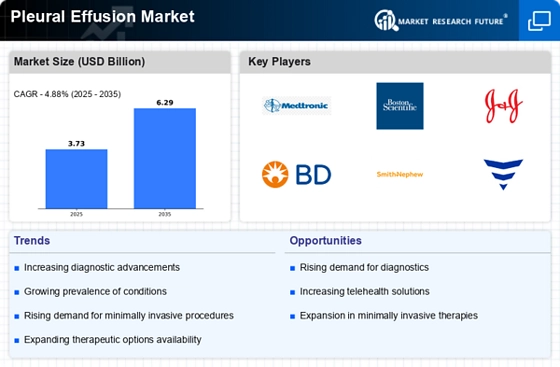Growing Geriatric Population
The expanding geriatric population is a crucial factor influencing the Pleural Effusion Market. Older adults are more prone to developing conditions that lead to pleural effusion, such as heart failure and malignancies. As the demographic landscape shifts, the demand for effective management of pleural effusion is expected to rise. Data indicates that the proportion of individuals aged 65 and older is increasing, which may result in a higher incidence of respiratory diseases and related complications. This demographic trend suggests that healthcare providers will need to focus on tailored treatment strategies for older patients, thereby driving growth in the Pleural Effusion Market.
Rising Healthcare Expenditure
The upward trend in healthcare expenditure across various regions is a significant driver for the Pleural Effusion Market. Increased investment in healthcare infrastructure and services allows for better access to diagnostic and treatment options for pleural effusion. As governments and private sectors allocate more resources to healthcare, the availability of advanced medical technologies and skilled professionals is likely to improve. Market data suggests that higher healthcare spending correlates with enhanced patient care and outcomes, which may lead to a greater demand for pleural effusion management solutions. This trend indicates a positive outlook for the Pleural Effusion Market as healthcare systems evolve to meet the needs of patients.
Advancements in Medical Technology
Technological innovations in medical devices and diagnostic tools are significantly influencing the Pleural Effusion Market. The introduction of advanced imaging techniques, such as ultrasound and CT scans, enhances the accuracy of pleural effusion diagnosis. Moreover, the development of minimally invasive procedures, such as thoracentesis and pleural catheterization, has improved patient outcomes and reduced recovery times. Market data indicates that the adoption of these technologies is on the rise, as healthcare facilities seek to provide efficient and effective care. This trend not only facilitates timely interventions but also contributes to the overall growth of the Pleural Effusion Market, as more patients gain access to these advanced treatment options.
Increasing Awareness and Education
There is a growing awareness regarding pleural effusion and its implications among both healthcare professionals and patients. Educational initiatives aimed at improving understanding of respiratory conditions are likely to drive the Pleural Effusion Market. As more individuals become informed about the symptoms and treatment options available, the demand for diagnostic services and therapeutic interventions may increase. Furthermore, healthcare providers are increasingly prioritizing patient education, which could lead to earlier diagnosis and treatment of pleural effusion. This heightened awareness is expected to contribute positively to market growth, as it encourages proactive management of respiratory diseases and pleural effusion.
Rising Incidence of Respiratory Diseases
The increasing prevalence of respiratory diseases, such as pneumonia and lung cancer, is a primary driver of the Pleural Effusion Market. As these conditions often lead to pleural effusion, the demand for diagnostic and therapeutic interventions is likely to rise. According to recent data, respiratory diseases account for a substantial portion of global morbidity and mortality, which may further escalate the need for effective management strategies. This trend suggests that healthcare providers are increasingly focusing on early detection and treatment options, thereby propelling the growth of the Pleural Effusion Market. Furthermore, the aging population is more susceptible to these diseases, indicating a potential increase in market demand as the demographic shifts continue.


















Leave a Comment